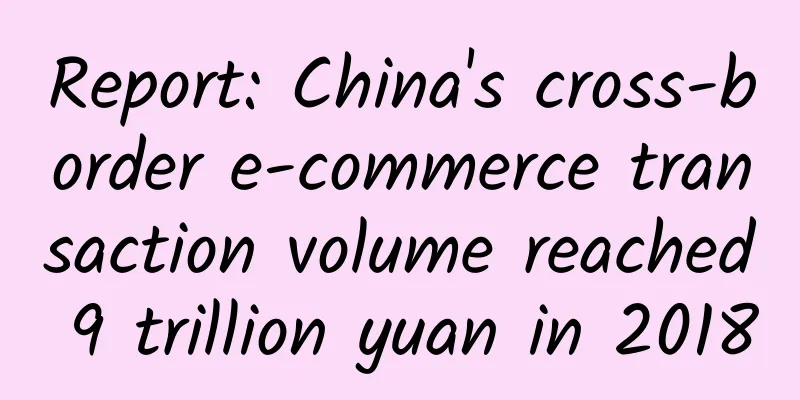Report: China's cross-border e-commerce transaction volume reached 9 trillion yuan in 2018

|
On June 5, the E-commerce Research Center, a well-known domestic e-commerce think tank under the China Internet Network Information Center, released the "2018 China Cross-border E-commerce Market Data Monitoring Report". The report shows that the scale of China's cross-border e-commerce transactions reached 9 trillion yuan in 2018, an increase of 11.6% year-on-year. In this regard, Zhang Zhouping, director of the B2B and cross-border e-commerce department and senior analyst of the E-commerce Research Center of China Internet Network Information Center, said that China's cross-border e-commerce continued to grow in 2018, thanks to a series of institutional support and reform and innovation, as well as the improvement of Internet infrastructure and the construction of a global logistics network. The transaction scale is expanding, and cross-border e-commerce is growing into a new driving force for China's foreign trade growth. In order to accelerate the development of cross-border e-commerce, the State Council has set up 22 cross-border e-commerce comprehensive pilot zones. As an emerging industry, cross-border e-commerce has been able to develop rapidly under the support of policies. In addition, with the continuous promotion of service providers such as Zhuozhi, all parties have promoted the vigorous development of cross-border e-commerce. In terms of import and export structure, in 2018, exports accounted for 78.9% of China's cross-border e-commerce import and export structure, and imports accounted for 21.1%. In the cross-border e-commerce transaction structure, exports still occupy a dominant position, and brand overseas has become the mainstream trend in recent years. In export e-commerce, factors such as huge overseas market demand and the transformation and upgrading of foreign trade enterprises have promoted the rapid development of the industry and attracted more companies to go online. The report shows that in terms of the structure of cross-border e-commerce transaction models, in 2018, cross-border e-commerce B2B transactions accounted for 83.2% of China's cross-border e-commerce transaction models, and cross-border e-commerce B2C transactions accounted for 16.8%. The B2B model accounts for more than 80% of the cross-border e-commerce model and has been the dominant business model for many years. The business model of cross-border e-commerce B2B is to remove the middleman, allowing brands and products to come into direct contact, and react to the production and brand side through users. More and more B2C cross-border e-commerce platforms have been established, directly connecting factories and consumers across many intermediate links, reducing transaction links in the form of B2B2C and eliminating information asymmetry. The B2C model is more flexible than traditional foreign trade and other forms by breaking down the whole into parts and selling to the terminal. The report shows that in the field of cross-border e-commerce service providers, a number of excellent companies have emerged around cross-border logistics, payment, insurance, and comprehensive service providers, such as Pingpong and Zhuozhi Technology. Zhuozhi has now become a comprehensive cross-border e-commerce service provider, covering: cross-border e-commerce, logistics supply chain, international trade, supply chain finance and other sectors. PingPong has become a cross-border payment unicorn company in 4 years. As a comprehensive foreign trade service platform, Yidatong has obvious advantages in customs clearance, tax refund, foreign exchange and other aspects. In 2018, the total revenue of listed cross-border e-commerce companies reached 46.812 billion yuan, and the revenue rankings were: Cross-border E-commerce 21.533 billion yuan, Lianluo Interactive 13.989 billion yuan, Huading Shares 6.602 billion yuan, Guangbo Shares 2.048 billion yuan, LightInTheBox 1.53 billion yuan, Tianze Information 895 million yuan, and Newway International 215 million yuan. In terms of revenue, there are two companies with annual revenue exceeding 10 billion yuan, which are in the first echelon, namely Cross-border E-commerce and Lianluo Interactive. In the second echelon are Huading Shares, Guangbo Shares, LightInTheBox, etc. In terms of net profit ranking, Cross-border Communication has 622 million yuan, Huading shares has 260 million yuan, Tianze Information has 24 million yuan, Xinwei International has -72 million yuan, LightInTheBox has -402 million yuan, Lianluo Interactive has -668 million yuan, and Guangbo shares has -677 million yuan. In terms of net profit, there is a "ice and fire" scene. Cross-border Communication's net profit is far ahead of other cross-border e-commerce listed companies, forming a strong contrast with Lianluo Interactive and Guangbo shares. Compared with the same period last year, Huading shares has achieved steady growth, while Cross-border Communication, Tianze Information, and Xinwei International have all declined. In terms of financing events, there were 16 investment and financing events in China's export cross-border e-commerce industry in 2018, with a total financing amount of more than 12.5 billion yuan. In 2018, the number of financing events decreased by half compared with 2017, but the total financing amount increased by 5.373 billion yuan year-on-year. There were three events with financing amounts exceeding 1 billion yuan, namely Tongtuo Technology, Zhiyu, and Lianlian Payment, and the amount of these three companies accounted for more than 70% of the total financing amount. In the financing of export e-commerce, service providers around the development of the cross-border e-commerce industry chain accounted for a large proportion. Distributed in the fields of finance, logistics, payment, insurance, data, etc., service providers play an indispensable role in the development of cross-border e-commerce, giving birth to excellent service provider companies such as Feishu Interactive. The construction of a complete industrial chain system is crucial, and capital-intensive layout in the service provider field is seen as the birth of more service needs with the vigorous development of the industry. In 2018, China's export cross-border e-commerce sellers were mainly concentrated in Guangdong Province (20.5%), Zhejiang Province (17.2%), Jiangsu Province (12.8%), Shanghai (8.3%), Fujian Province (6.5%), Beijing (5.2%), Shandong Province (3.4%), Hebei Province (2.2%), and other regions (23.9%). Currently, China's export cross-border e-commerce sellers are mainly concentrated in the Yangtze River Delta and the Pearl River Delta, especially in Guangdong, Zhejiang, and Jiangsu. These regions are also the most developed regions for traditional foreign trade and have a good traditional foreign trade foundation. In terms of category distribution, in 2018, the category distribution of Chinese export cross-border e-commerce sellers was 3C electronic products 18.5%, clothing and accessories 12.4%, home gardening 8.5%, outdoor products 6.5%, health and beauty 5.2%, shoes and hats 4.7%, maternal and child toys 3.5%, auto parts 3.2%, lighting 2.3%, security monitoring 1.7%, and others 35.2%. In terms of categories, 3C electronic products, clothing and accessories and other consumer goods have always been the best-selling categories on cross-border e-commerce platforms, and the demand for home gardening, outdoor products, etc. has also increased dramatically. The report shows that in 2018, the main countries and regions for China's cross-border e-commerce exports were: the United States 17.5%, France 13.2%, Russia 11.3%, the United Kingdom 8.4%, Brazil 5.6%, Canada 4.5%, Germany 3.7%, Japan 3.4%, South Korea 2.5%, India 2.4%, and others 27.5%. From the distribution of major countries and regions, developed countries such as the United States and France are still the main destinations for China's e-commerce exports. Factors such as complete infrastructure, a relatively mature online shopping environment and population have contributed to the high level of development of e-commerce. Development Trends of Cross-border E-commerce Exports Trend 1: The road to cross-border export B2B branding will be opened. Currently, most cross-border B2B companies have insufficient corporate brand building and still play the role of OEM for international brands. However, the road to cross-border B2B brand building is about to be opened. More and more B2B platforms and companies on the platforms are beginning to focus on brand building and enhance the company's products and overall value through brand premium. Trend 2: Cross-border e-commerce companies are clearly building their own independent websites. Since 2018, cross-border e-commerce companies have begun to build their own independent websites in the export cross-border e-commerce field, and sell their products and services to consumers through independent websites. The main reason is that the platform has a large number of sellers, resulting in fierce competition, and sellers need to find new growth channels. In addition, there is a trend brought about by the upgrade of marketing automation. Trend 3: Branding is accelerating as Chinese products move towards becoming global brands. In recent years, branded companies going overseas have become a landscape of export e-commerce, and major traditional foreign trade companies have accelerated the pace of branding. In addition, major cross-border e-commerce platforms are also working hard to create and incubate more overseas branded companies, and the road to branding through the Internet has ushered in a golden period of development for companies. |
>>: Use SEO to increase product exposure on eBay
Recommend
How is Haohang Yuntong International Freight Forwarding? What services does Haohang Yuntong International Freight Forwarding provide?
How about Haohang Yuntong International Freight F...
What is Wahool? What services does Wahool provide?
What is Wahool? Wahool was founded in 2014 by Bei...
What is Magento? What is the Magento framework like?
What is Magento? Magento is an open source e-comm...
What actions may trigger eBay account association?
ebay/" target="_self">The main ...
What is Global Sources? What products and services does Global Sources provide?
Global Sources has been building a trusted B2B pl...
Features of GOST-R certificate, which is valid for one year
What are the characteristics of a GOST-R certific...
How is Yimaibao? What are the advantages of Yimaibao?
How about Yimaibao? Yimaibao is a cloud service p...
Social Responsibility Compliance Audit Checklist (II)
Carrefour Factory name: XX Dacheng Toys Co., Ltd....
Due to the arrival of Typhoon Fitow, Zhejiang was affected by floods, and Yuyao was particularly hard hit. Please pray for Zhejiang.
Yuyao, impact, Shaoxing, Zhejiang, rainfall Yuyao...
Timberland_Timberland factory audit procedures and methods
Timberland_Timberland factory audit procedures and...
What is eBay's Qianfan Plan? What content does eBay's Qianfan Plan support?
What is eBay's Qianfan Plan? The core of the ...
What is CloudMail? What are the functions of CloudMail?
What is CloudMail? Yunyou is the second-generatio...
What is LazMall? What are the advantages of LazMall?
What is LazMall? LazMall is the official store la...
Bon-Ton factory inspection consultation content standards
This Code of Vendor Conduct applies to vendors/sup...
WAL-MART factory inspection 2013 latest fire protection standards
Recently, some European and American brands or im...









